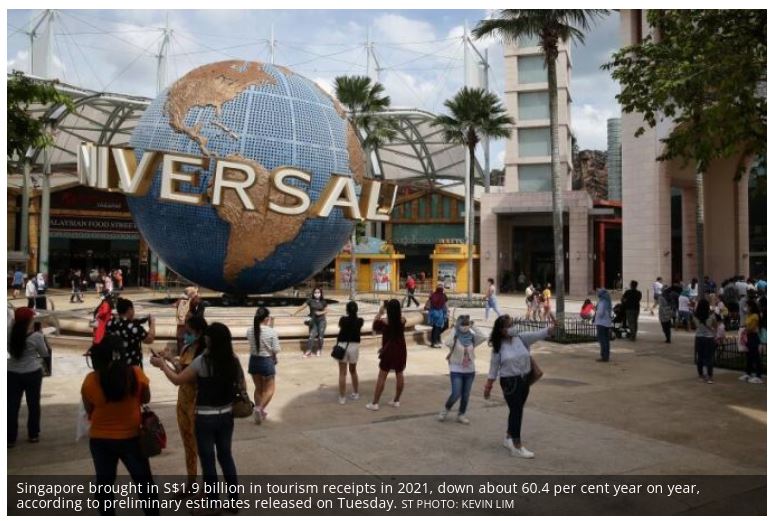Singapore tourism receipts fall 60.4% to S$1.9b in 2021; no forecast for 2022
SINGAPORE brought in S$1.9 billion in tourism receipts in 2021, down about 60.4 per cent year on year, according to preliminary estimates released on Tuesday (Jan 25).
The decline came on a continued slump in international arrivals, with the Singapore Tourism Board (STB) noting that the tourism sector stayed pivoted towards domestic consumption.
In contrast, Singapore had recorded about S$4.8 billion in tourism receipts in 2020, and some S$27.7 billion in 2019, before the Covid-19 pandemic began.
But Keith Tan, chief executive of the STB, said at a press briefing that he would not give projections about tourism performance in 2022 “because we don’t have confidence in the ability to predict because many markets are still uncertain, the situation is very uncertain”.
“We should not expect tourism to recover in a predictable and linear fashion, and we must be prepared for further surprises, good or bad… but hopefully no complete stops to the pace of border reopening and the recovery of international travel,” he added.
The STB had attributed the year-on-year decline in receipts and arrivals to stronger performance in the first 2 months of 2020, before international travel was disrupted by the pandemic. Singapore welcomed about 330,000 visitors in 2021, down from 2.74 million in 2020.
Otherwise, tourism receipts for the April-to-September period still came in 92 per cent higher in 2021 than in the year before, the agency noted in its statement. Tourism receipts comprise spending by visitors, including transit passengers and foreign air and sea crew, both during their stay in Singapore and in pre-paid bookings such as tours and accommodation.
That’s as the STB worked to drive domestic demand with S$320 million in SingapoRediscovers Vouchers (SRV) that gave adult Singaporeans credits to spend on hotels, tours and attractions. The scheme yielded about S$300 million in SRV transactions between its launch in late 2020 and its conclusion in end-2021, including S$120 million in out-of-pocket spending.
As such, the tour industry drew close to 320,000 local participants in 2021, while the cruise sector carried more than 400,000 domestic passengers in 2021 on roughly 300 sailings. Passenger throughput was about 410,000 in 2020, and nearly 1.82 million in 2019.
Still, Tan acknowledged that the tourism sector in Singapore cannot depend on domestic support: “That is why we now have, this year, we will have a stronger focus, pivoting back towards international markets and international visitors coming to Singapore.”
The STB also noted that the introduction of quarantine-free Vaccinated Travel Lanes (VTLs) for foreign short-term visitors “has encouraged the gradual return of international travellers”.
The STB will work to simplify the processes and documentation required, and will work with other government agencies “to expand the scope and the reach of the VTLs”, said Tan.
The STB reported “healthy demand from VTL markets” since the scheme was rolled out in September 2021, with more than 100,000 Vaccinated Travel Passes issued for short-term entry to Singapore by air in the September-to-December period. India, Malaysia, Indonesia, Australia and the United Kingdom were the top source markets by applications.
Telling the press that “our attractiveness has remained undimmed”, Tan also said that the STB will step up efforts in 2022 to reach out to international audiences, especially in markets with VTL flights and two-way quarantine-free travel.
But even before the VTLs kicked in, visitors from China contributed S$432 million in tourism receipts – excluding sightseeing, entertainment and gaming – in the first 9 months, while arrivals from Indonesia brought in S$127 million and travellers from India contributed S$58 million.
Singapore has since launched VTLs with Indonesia and India, and Juliana Kua, assistant CEO of the STB’s international group, added that the agency is “extremely confident” that China will remain a key market in terms of mid and long-term tourism potential.
Outbound travel restrictions are still in place in China, which is pursuing a zero-Covid elimination strategy towards the coronavirus. But Kua noted that Singapore has continued to invest in marketing activities in China even during the pandemic.
“Chinese are very eager to come to Singapore once there is quarantine-free travel on both sides, and thus we are well prepared for that,” she said.
Separately, Singapore hosted more than 200 meetings, incentives, conventions and exhibitions (Mice) events in 2021, with about 50,000 local and international attendees.
Full-year hotel industry metrics were largely stable year on year, with the average room rate at S$158; revenue per available room at S$89; and average occupancy at 56.2 per cent, the STB noted.
Source: https://www.businesstimes.com.sg/government-economy/singapore-tourism-receipts-fall-604-to-s19b-in-2021-no-forecast-for-2022


 English
English




